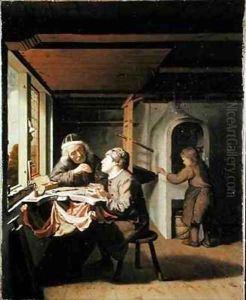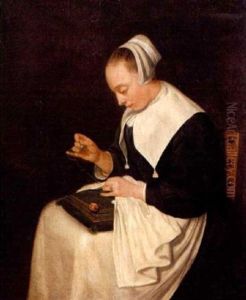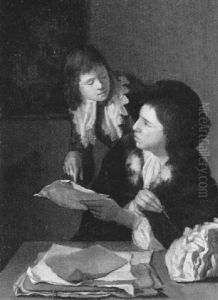Olivier van Deuren Paintings
Olivier van Deuren was a Dutch painter born in 1666, during a period known as the Dutch Golden Age, which is characterized by its dramatic growth in Dutch painting, trading, and science. Not as widely recognized as some of his contemporaries, van Deuren's contributions to art history, however, hold a quiet significance, especially in the realms of genre painting and portraiture. His life spanned a period of artistic innovation and the development of new painting techniques, which he both witnessed and contributed to in his own unique manner.
Van Deuren's work is often characterized by its meticulous attention to detail, a hallmark of Dutch Golden Age paintings. He specialized in genre scenes that depicted everyday life with an extraordinary sense of realism and emotional depth. These scenes were popular among Dutch middle-class patrons who favored the portrayal of moralistic and domestic virtues. Furthermore, his portraits exhibited a keen observation of character and a mastery in rendering textures and fabrics, which made them highly sought after by the elite of his time.
Despite the lack of extensive records on his life, it is believed that van Deuren received his artistic training in the Netherlands, which was a center for artistic innovation during the 17th century. He might have been influenced by the works of more prominent Dutch Golden Age artists such as Rembrandt, Vermeer, and Frans Hals, whose styles deeply impacted the trajectory of European art. Van Deuren's own style, while reflective of the broader trends of his time, also exhibited a unique sensitivity to light and shadow, contributing to the evocative atmospheres in his paintings.
Olivier van Deuren's career reflects the vibrant artistic culture of the Dutch Republic, where art served not only as a reflection of economic prosperity but also as a medium for moral and philosophical contemplation. Though not as well-documented as some of his peers, his contributions to Dutch art were nonetheless significant, with his paintings continuing to be appreciated for their beauty and historical value. Van Deuren passed away in 1714, leaving behind a legacy that, while modest in comparison to the giants of his era, offers a fascinating glimpse into the diversity and depth of Dutch Golden Age painting.


